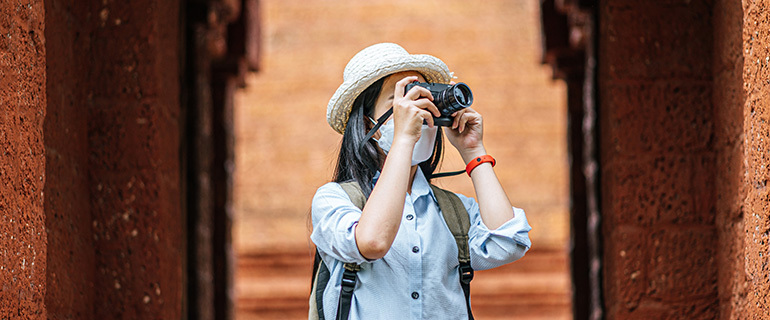Luxury travel is not just about experiencing high-end resorts and hotels, dining at the most favoured restaurants, or booking guided tours and trips for an enhanced experience. It is more than just the cosmetic attributes; luxury travel is also about experiencing the local culture and traditions. As a luxury traveller visiting India, you must know about the diverse and rich heritage of the country and be familiar with cultural etiquette. True appreciation of the wonders of this varied nation depends on knowing the Indian cultural etiquette. If you want to ensure your visit is culturally sensitive and engaging, this blog will help you follow and respect the social rules.
1. Value of courtesy
In India, everyday contacts revolve around greetings. The customary welcome, “Namaste,” expresses humility and respect rather than words. Place your hands together in front of your chest, and gently bend your head to welcome someone. In formal environments, particularly among males, a handshake might also be suitable; waiting for the other person to start is advisable.
2. Suitable clothing
Your appearance in India will be much influenced by the clothes you choose. Although luxury tourists usually have access to high-end fashion, it’s important to dress modestly, especially in rural or religious locations. In India’s warm temperature, fabrics such as cotton or silk are both fashionable and comfy. Both men and women should avoid shorts in traditional places.
Follow more rigorous clothing rules while visiting religious locations. In Hindu temples, for example, removing shoes is required, and it is traditional to dress in a way that covers the arms and legs. Some temples might even ask that you cover your head. Attuning yourself to these norms shows respect and improves your whole experience.
3. Respecting religious sites
India has churches, mosques, gurdwara, and temples, all of which have great spiritual value. Observing the traditions unique to every holy place you visit is important. For instance, it is traditional in Hindu temples to enter with a pure mind and heart; photography could be forbidden in certain regions. Ask a local or search for signs if you are unsure about the regulations.
Furthermore, see how people around you behave. Maintaining the dignity of these sites depends on one keeping polite behaviour.
4. Gaining knowledge of personal space
Cultural ideas of personal space differ greatly, and India is no exception. Personal space may be more communal in rural places but more inclined towards Western cultures in metropolitan settings. Ask residents how comfortable they feel with closeness. Although some people value proximity, others may choose a little more space. Watch body language and make necessary changes.
5. Dining etiquette
Dining in India is a social affair rich with customs rather than just food. Should you be welcomed to a local house, you could discover that many portions of the nation—especially rural areas—have a habit of eating with their hands. Although some may find this intimidating, it is a custom rich in history and usually seen as a means of closer connection to the meal. If you would rather use a spoon and fork, that is fine; however, if you feel comfortable, try participating in the local tradition.
6. Photographer courtesy
While capturing India’s splendour with pictures is tempting, one should be courteous. In rural places especially, always get permission before photographing people. Many religious locations may have outright bans on photography, so if you’re unsure, search for signs or contact a local guide. Respect for these limits shows excellent behaviour and promotes harmony among the residents.
7. Local celebrations and customs
The vivid celebrations of India are woven into its cultural fabric. If you visit during a celebration, including Diwali or Holi, seize the chance to engage in polite participation. Knowing the significance of these holidays improves your experience. However, be aware of cultural sensitivity and avoid engaging in acts that are seen to be insulting.
For instance, residents participate in lighthearted festivities during Holi, the festival of colours, but it’s important to recognize when and where it would be suitable to join in. Always act in a way that respects the conventions and follow the example of those around you.
8. Gift-giving traditions
Delivering a modest gift as a thank-you gesture is usual if you are welcomed into someone’s house. Usually, a wise option is sweets or flowers. In many Indian societies, the left hand is considered dirty; hence, while offering a gift, use either both hands or only the right hand.
9. Speaking respectfully
In India, there are somewhat different ways of communicating. While certain areas welcome direct contact, others might choose a more subdued approach. When interacting with residents, speak politely and gently. Only discuss delicate subjects like religion or politics if you know the individual. Knowing conversational limits will assist in establishing rapport and confidence.
10. Accepting variability
India is a collage of many languages, faiths, and cultures rather than a monolithic one. Every area has particular traditions. People greet each other or dress differently, for example, depending on the state. Learning about these cultural etiquettes in India can help you, as a luxury tourist, improve your trip and create closer bonds.
Research regarding the cultural etiquette in India of the places you want to visit will enable you to interact more deliberately with the culture. Every area, from the subtle beauty of Kerala to the rich cultures of Rajasthan, presents a unique experience worth discovering.
